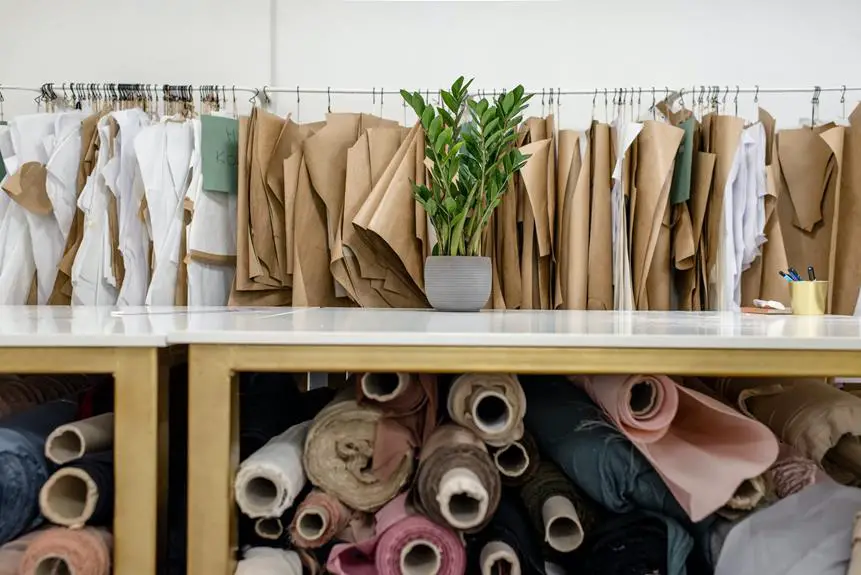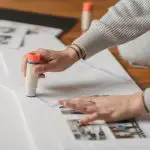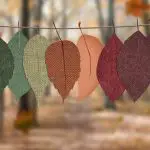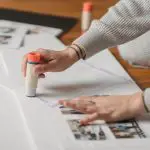So, you've heard the saying 'a stitch in time saves nine,' but what about when you need a quick fix for fabric? Can Gorilla Glue be used on fabric? It's a common question, especially when you're looking for a strong adhesive for your fabric projects.
In this brief guide, we'll explore the compatibility of Gorilla Glue with different types of fabric, how to prepare and apply it, and important considerations for washability and durability.
Whether you're a seasoned DIY enthusiast or just delving into fabric crafts, mastering the use of Gorilla Glue on fabric can be a game-changer for your projects.
Key Takeaways
- Gorilla Glue is compatible with rough-textured fabrics like denim and canvas, but may not be as effective on smoother fabrics like silk or satin.
- Different Gorilla Glue products have different compatibility with fabric.
- Preparing the fabric surface by cleaning and removing loose particles is important before applying Gorilla Glue.
- Gorilla Glue may not withstand frequent washing or exposure to water, so fabric glues specifically designed for textiles may be a better option.
Gorilla Glue: Fabric Compatibility
If you're considering using Gorilla Glue on fabric, be aware that its compatibility with fabric varies depending on the type of fabric and the specific Gorilla Glue product. When it comes to fabric bonding, Gorilla Glue can work well on certain fabrics like denim or canvas due to their rough texture, but it may not be as effective on smoother fabrics like silk or satin. Additionally, the specific Gorilla Glue product used also plays a crucial role in determining its compatibility with different fabric types.
When it comes to fabric durability and washability, it's essential to consider the type of bond you need. While Gorilla Glue can create a strong bond on fabric, it may not withstand frequent washing or exposure to water. If you require a more washable and durable option, exploring fabric glues specifically designed for textiles might be a better alternative. These fabric glues are formulated to maintain flexibility, withstand washing, and provide a durable bond suitable for various fabric types.
Types of Fabric Suitable for Gorilla Glue
Gorilla Glue can effectively bond with rough-textured fabrics like denim or canvas due to their porous surfaces, making them suitable for use with this adhesive.
When choosing fabrics for Gorilla Glue, consider the following types:
- Denim: The coarse and rugged texture of denim makes it an ideal candidate for bonding with Gorilla Glue. Whether you're repairing a pair of jeans or working on a DIY denim project, Gorilla Glue can provide the adhesive strength needed for a durable bond.
- Canvas: Similar to denim, canvas fabric's rough and porous nature allows for excellent adhesion with Gorilla Glue. This makes it a great choice for various applications such as repairing canvas bags or bonding canvas patches onto other materials.
- Burlap: The coarse and open weave of burlap fabric makes it compatible with Gorilla Glue. Whether you're crafting rustic decorations or repairing burlap items, Gorilla Glue can deliver the adhesive strength required for a reliable bond.
These fabrics not only offer excellent adhesive strength with Gorilla Glue, but their rough textures and porosity enhance the bonding process, making them suitable choices for various projects.
Preparing Fabric for Gorilla Glue Application
Before applying Gorilla Glue to fabric, it's crucial to ensure the fabric surface is clean and free from any dirt, oils, or residues. You can do this by gently washing the fabric and allowing it to dry completely before proceeding with the application.
Additionally, it's wise to test the Gorilla Glue on a small, inconspicuous area of the fabric first to ensure compatibility and to assess the bonding strength.
Fabric Surface Cleanliness
To prepare fabric for Gorilla Glue application, start by ensuring the fabric surface is free from any dirt, dust, or debris. This will help to create a clean and smooth surface for the glue to adhere to, ensuring a strong bond.
Here's how to ensure fabric surface cleanliness:
- Gently brush the fabric with a soft-bristled brush to remove any loose particles.
- Use a lint roller to pick up any remaining dust or lint from the fabric surface.
- If the fabric is washable, consider washing and thoroughly drying it before applying the Gorilla Glue for optimal cleanliness and adhesion.
Testing on Small Area
Ensure the fabric surface is clean and free from any debris before proceeding to test Gorilla Glue on a small area for adhesion.
To begin the testing process, select a discreet area of the fabric and apply a small amount of Gorilla Glue. Gently press the fabric together and hold it in place for the recommended drying time.
Once the adhesive has fully cured, carefully examine the bonded area. Check for any signs of adhesion failure, such as peeling or separation.
Assess the adhesive strength by attempting to gently pull the fabric apart. If the fabric remains securely bonded, the Gorilla Glue may be suitable for use on the specific type of fabric.
This testing process allows you to determine the compatibility of Gorilla Glue with the fabric before committing to a larger application.
Applying Gorilla Glue to Fabric
Now that you've prepared your fabric for the application of Gorilla Glue, it's time to discuss the process of actually applying the glue to the fabric.
We'll explore whether Gorilla Glue is suitable for use on fabric and the steps you need to take to ensure a successful application.
Understanding the intricacies of applying Gorilla Glue to fabric will help you achieve the best results for your project.
Gorilla Glue Fabric Suitability
You can apply Gorilla Glue to fabric for a strong and durable bond. When using Gorilla Glue on fabric, it's important to consider the following:
- Material Compatibility: Ensure that the fabric you're using is suitable for adhesive application. Natural fibers like cotton and wool, as well as synthetic fabrics such as polyester and nylon, generally work well with Gorilla Glue.
- Surface Preparation: Clean the fabric surface thoroughly to remove any dirt, dust, or oil that could hinder adhesion.
- Application Technique: Apply a small amount of Gorilla Glue to one of the fabric surfaces, press the pieces firmly together, and use a clamp or heavy object to hold them in place until the glue sets.
Gorilla Glue can be an effective option for fabric adhesion, but it's also beneficial to explore Gorilla glue alternatives for specific fabric types.
Preparing Fabric for Application
Preparing fabric for applying Gorilla Glue involves thoroughly cleaning the fabric surface to remove any dirt, dust, or oil that could hinder adhesion. Ensuring the fabric is compatible with the adhesive is crucial for a successful bond. Check the fabric's composition to determine if it is suitable for use with Gorilla Glue. Here's a helpful guide to preparing fabric for application:
| Preparation Steps | Description |
|---|---|
| Clean the Fabric | Use mild detergent to remove any dirt, dust, or oil from the fabric. Allow it to dry completely. |
| Check Fabric Compatibility | Ensure the fabric is compatible with Gorilla Glue by referring to the manufacturer's guidelines. |
| Test Adhesive Strength | Before applying Gorilla Glue to the entire fabric surface, conduct a small test to evaluate the adhesive strength. |
Considerations for Washability and Durability
When using Gorilla Glue on fabric, it's important to consider the washability and durability of the bond. Ensuring that the bond can withstand washing and maintain its strength over time is crucial for any fabric-related project. Here are some key considerations to keep in mind:
- Washability considerations: Before using Gorilla Glue on fabric, carefully review the washing instructions for the fabric. Some fabrics may require special care or may not be suitable for washing, which can impact the durability of the bond.
- Durability testing: It's advisable to conduct a small-scale test to assess how well the bond holds up to washing and everyday wear. This can help gauge the long-term durability of the bond before committing to a larger project.
- Fabric compatibility, adhesive alternatives: Not all fabrics are compatible with Gorilla Glue, and some may require specific types of adhesives for optimal results. Research fabric compatibility and consider alternative adhesives if Gorilla Glue may not be the best option for your specific fabric.
Considering these factors will help you make an informed decision and achieve a durable, wash-friendly bond when using Gorilla Glue on fabric.
Common Mistakes When Using Gorilla Glue on Fabric
To ensure successful bonding when using Gorilla Glue on fabric, caution against negligence in surface preparation. Common mistakes often lead to compromised fabric adhesion properties. Here are some pitfalls to avoid:
| Common Mistakes | Effects on Fabric Adhesion Properties |
|---|---|
| Insufficient cleaning of the fabric surface | Residue can hinder the glue from properly adhering to the fabric. |
| Over-application of Gorilla Glue | Excess glue can seep through the fabric, creating a stiff or uneven texture. |
| Failure to clamp the fabric during drying | Without proper pressure, the glue may not bond evenly, leading to weak spots. |
| Using the wrong type of Gorilla Glue | Not all Gorilla Glue variants are suitable for fabric, leading to poor adhesion. |
| Ignoring the curing time | Premature handling can disrupt the bonding process, affecting adhesion strength. |
Alternative Adhesives for Fabric Projects
When considering fabric projects, it is important to explore using alternative adhesives that provide flexibility and durability for your specific needs. There are various fabric bonding options and alternatives to consider for your fabric repair and crafting adhesives.
Here are some alternatives to Gorilla Glue that you can use for your fabric projects:
- Fabric Glue: Specifically designed for fabric, this adhesive provides a strong bond and remains flexible after drying, making it ideal for a wide range of fabric projects.
- Hot Glue Gun: A versatile option for quick fabric repairs and crafting, hot glue guns offer a strong bond and can be used on a variety of fabrics. However, it's important to use caution to avoid burns and ensure proper adhesion.
- Fusible Web: This adhesive comes in sheets or rolls and is activated by heat. It is commonly used for hemming, appliqué, and other fabric bonding needs, providing a durable and flexible bond.
These alternatives offer reliable bonding options for fabric projects, ensuring that your creations are both sturdy and long-lasting.
Safety Precautions When Using Gorilla Glue on Fabric
Before using Gorilla Glue on fabric, carefully read and follow the safety precautions provided by the manufacturer. When working with fabric bonding, safety should always be a top priority. Gorilla Glue is a powerful adhesive, and it's crucial to take the necessary precautions to ensure a safe and successful fabric adhesion process.
First and foremost, it's essential to work in a well-ventilated area when using Gorilla Glue. The fumes from the glue can be strong, so proper ventilation will help minimize inhalation exposure. Additionally, wearing gloves is highly recommended to prevent skin contact with the adhesive. Gorilla Glue can bond quickly and be challenging to remove from skin, so taking this precaution is crucial for your safety.
Furthermore, it's important to avoid direct contact between Gorilla Glue and your eyes. In case of accidental contact, rinse your eyes thoroughly with water and seek medical attention immediately. Additionally, keep the glue away from children and pets, as it can be harmful if ingested.
Frequently Asked Questions
Can Gorilla Glue Be Used on Delicate Fabrics Like Silk or Chiffon?
When it comes to delicate fabrics like silk or chiffon, using Gorilla Glue may not be the best idea. While it's heat resistant and great for outdoor fabric repairs, it may not work well with stretchy or waterproof materials.
Is It Safe to Use Gorilla Glue on Fabric That Will Be Exposed to Extreme Heat or Cold?
Using Gorilla Glue on fabric exposed to extreme heat or cold isn't recommended. Chemical reactions can occur, compromising the bond. To avoid this, select appropriate adhesives and application techniques for fabric projects.
Will Gorilla Glue Work on Waterproof or Water-Resistant Fabrics?
Gorilla glue can bond well with cotton and polyester fabric, making it suitable for waterproof or water-resistant fabrics. However, be cautious with its use, as it may not be as flexible as other fabric glues.
Can Gorilla Glue Be Used to Repair Outdoor Fabric Items Like Tents or Awnings?
You can use Gorilla Glue to repair canvas and patch denim. It's strong and durable, making it suitable for outdoor fabric items like tents or awnings. Just ensure you follow the instructions for best results.
Are There Any Special Considerations for Using Gorilla Glue on Stretchy or Elastic Fabrics?
When using Gorilla Glue on denim or stretchy fabrics, consider the fabric's elasticity. For repairing athletic wear, be cautious of how the glue may affect the fabric's stretch. Always use Gorilla Glue carefully on elastic fabrics.
- Does Chiffon Fabric Stink - July 15, 2025
- Does Chiffon Fabric Affect the Economy - July 15, 2025
- Does Cotton Fabric Have a Nap - July 15, 2025







